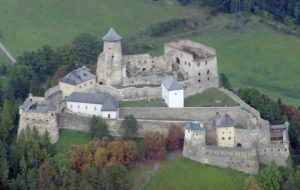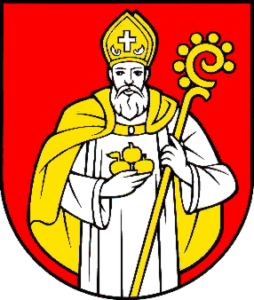
Here are more pictures of Ólubló castle:

Ólubló aka Lubló (Ľubovniansky Hrad, Altlublau) is located in the Upper lands/Horná Zem/Felvidék. It is in Slovakia, 15 kilometers from the Polish border. The castle is a bit apart from the town, sitting on a 548-meter-high cliff. Lubló was one of the 13 towns and castles of Hungary that were pledged to Poland for 360 years by King Zsigmond in 1412, in exchange for 37,000 pieces of “wide” silvers that he spent on his wars against Venice.
Lubló is one of the oldest of the Zips (Cips, Spis, Szepesség) towns. The Zips towns were inhabited mostly by German people who had been invited there by King Béla IV of Hungary in the 13th century. Here is more about the Zips Lands aka Szepesség / Spiš:
https://www.hungarianottomanwars.com/essays/szepesseg/
Lubló was first mentioned in 1292 and its castle was built after 1299 by the Comes of Szepes County, on behalf of the Hungarian king. The fort was controlling the trade routes of the Northern Carpathian Mountains towards Poland. When the Hungarian Árpád Dynasty was discontinued (1301), it was Palatine Amádé of the powerful Aba Clan who took the land. King Károly Róbert managed to retake it from his sons, though.

The land was the honorary property of Palatine Drugeth Fülöp between 1323 and 1342, he was able to receive income from the villages that belonged to Lubló. Soon, Lubló became a free royal town in 1364. King Zsigmond gifted it to Baron Horváti Miklós in 1395. However, Zsigmond took the castle back from him in 1403 because Horváti switched sides and began to support the usurper László of Naples. (Note, I use the Eastern name order for Hungarians where family names come first.)
Please, look at this animation video of Fodor Zsolt about the castle:
https://www.youtube.com/watch?v=vGItj4d8H4s
King Zsigmond met King Ulászló II of Poland in the castle of Lubló in 1412 where they settled the business and the 16 Szepes towns, including Lubló, were pledged to Poland. Legally speaking, they remained part of the kingdom but the Polish were allowed to benefit from the income. Zsigmond thought that he would pay the loan back soon but it was finally the Habsburg Empress, Maria Theresa who simply reattached these towns to Hungary in 1772, without paying a penny to Poland that was being devoured at that time.

Lubló became the central administrative town for the Zips cities while under Polish rule. The leaders were called Starost (Hungarian: sztaroszta), Polish noblemen who were very wealthy and who were taking care of the Zips town for the Polish kings. They lived in the castle and they built it up nicely. The Bohemian Hussites took Lubló in 1433 and in 1461 again, though. New bastions were built in Italian fashion to answer the challenges of the developing artillery.

The castle burned down in 1553 but was rebuilt at once. The castle was owned by the Polish nobleman Count Sebastian Lubomirski in 1593. The magnificent Lubomirski-palace was completed in 1642, it is a nice example of the Renaissance style. The castle’s chapel was built in 1647.
The Polish coronational jewels were guarded here by Jerzy Sebastian Lubomirszki between 1655 and 1661 when the country was attacked by the Swedish king. After the Siege of Vienna in 1683, the victorious Polish King Jan Sobieski returned home via Lubló. He spent Christmas there but unfortunately, his troops were plundering the villages in the area.

A plague killed almost all the inhabitants in 1710. The town was repopulated by the Slovakian people. The castle is also famous for the Hungarian soldier and globe-trotter, Benyovszky Móric who was imprisoned there in 1768. The city returned to the Hungarian Kingdom when Habsburg Empress Maria Theresia’s troops took it back, taking advantage of the Polish troubles of state in 1769.

It lost its administrative function in 1772 but its walls were continuously maintained. Perhaps the saddest event that took place in the castle was in 1944 when Polish partisans were executed in it. In Lubló, archeological exhibitions have been going on since the 1970s. They had renovated the round tower of the inner castle by 2002.

Dear Readers, I can only make this content available through small donations or by selling my books or T-shirts:
Please, feel free to support me with a coffee here:
You can check out my books on Amazon or Draft2Digital, they are available in hardcover, paperback, or ebook:
https://www.amazon.com/dp/198020490X or at https://books2read.com/b/boYd81

My work can also be followed and supported on Patreon: Become a Patron!http://Become a Patron!
[wpedon id=”9140″]




Become a Patron! Send me a one-time donation via PayPal or "Buy me a Coffee":
Thank you very much, köszönöm szépen.